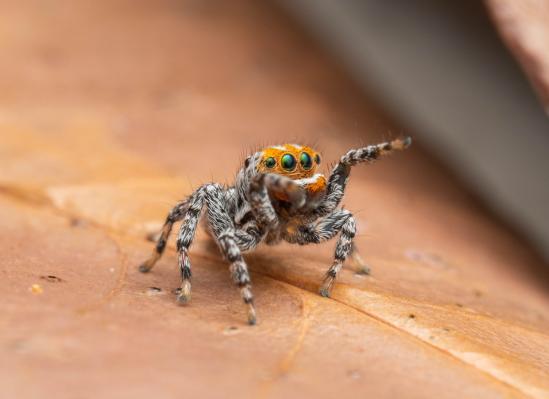
By Brett Kennedy
A NEW jumping spider species has been discovered living in Limestone Coast swamps with its vibrant orange head and white-striped body earning it the name Nemo.
Research released today by Museums Victoria’s Joseph Schubert identifies the peacock spider scientifically as Maratus nemo, the 92nd species within the genus.
It was first documented by Nature Glenelg Trust ecological field officer Sheryl Holliday while searching for orchids in a swamp near Nangwarry in November 2018, photographing the spider as it jumped through vegetation.
“I was out there looking for sun orchids and these little things caught my eye,” Ms Holliday said.
“I knew all about peacock spiders because I had spent around three years looking for them but when I saw this spider I didn’t know it was a peacock – I knew it was a jumping spider of some sort,” she said.
After posting the images to social media, Mr Schubert contacted Ms Holliday believing she had made a world-first discovery given the male spider’s vibrant colour appeared on its head, not the abdomen like a majority of peacock spiders.
The species’ seasonal nature meant it wasn’t until November last year that Ms Holliday was able to collect live specimens of the spider – each the size of a grain of rice – and send them to Victoria for further identification.
Immature male peacock spiders do not get their colouration until their final moult – a key element in distinguishing the species from other spiders – while the females are larger but remain brown in colour.
In a twist of irony given its name, one spider was collected on a fishing net while Ms Holliday was catching native fish at the Nature Glenelg Trust-managed Mount Burr Swamp.
“It is amazing to think this is the only place in the world this species has been found,” Ms Holliday said.
“Jumping spiders are everywhere – it is just a matter of tuning your eye for that tiny bit of movement.”
The Maratus nemo does not weave a web, stalking its prey using its superior vision, but it does create string-like strands when it jumps as a ‘safety rope’ and weaves small cocoon-like nests.
It is the 13th new species of spiders in the Maratus genus and 18th jumping spider Mr Schubert has identified, becoming a world-leading researcher at just 23 years of age.
Mr Schubert praised Ms Holliday for her work, highlighting the importance of citizen scientists in making new discoveries.
“Roughly only 30pc of Australia’s biodiversity has been formally documented scientifically, so this means we could be losing species before we even knew that they existed,” Mr Schubert said.
The colourful Maratus spider genus has grown in popularity in recent years thanks the peacock spiders’ small size and intricate mating ritual, a ‘dance’ which has been enhanced with music and photoshopped elements.
“I think peacock spiders have captured the public’s attention because they’re really, really cute – they’ve got these massive forward-facing eyes and you can kind of relate to them more than you could like a huntsman,” Mr Schubert said.
Overwhelmed by the interest in the new species, it is not the first time Ms Holliday has made a world-first discovery in the last decade working as an ecological field officer, a world away from her 20-year career with Australia Post.
With a long-held passion for finding and photographing orchids, Ms Holliday – a Mil Lel resident – discovered a tiny spotted blue flowered orchid now named helymitra abrupta, the Abrupt Sun Orchid.
The species had been reported on the Fleurieu Peninsula in the 1980s but had since disappeared, reemerging at the Marshes Native Forest Reserve north-west of Glencoe.
Humbled to have made the important ecological discoveries, Ms Holliday said the unique finds highlighted the importance of conservation.
“It is a reminder for people on the land that if they have a wetland, fence it off from livestock because you never know what could disappear before you even know about it,” Ms Holliday said.








